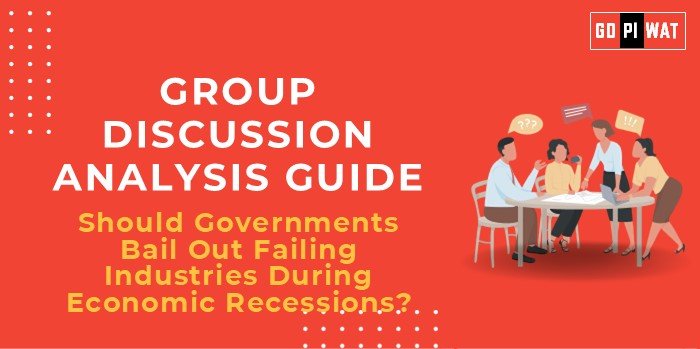📋 GD Analysis Guide
💸 Should Governments Bail Out Failing Industries During Economic Recessions?
🌟 Introduction to the Topic
Opening Context: “Economic recessions pose significant challenges for both public and private sectors, often resulting in large-scale unemployment, market instability, and weakened consumer demand. The debate around government bailouts for failing industries becomes particularly critical during such periods, as it reflects on broader economic resilience, social safety nets, and fiscal priorities.”
Topic Background: Government bailouts involve direct financial assistance or intervention to keep distressed industries afloat during economic downturns. Historically, bailouts have been used in major crises, such as the 2008 global financial crisis, to stabilize economies. The rationale behind such measures is to preserve jobs, ensure the continuation of critical industries, and avert broader economic collapse.
📊 Quick Facts and Key Statistics
- 💵 2008 Global Financial Crisis (U.S.): $700 billion was provided under the Troubled Asset Relief Program (TARP), stabilizing critical industries like banks and automakers. Taxpayers earned a positive return by 2014.
- 🇪🇺 European Union COVID-19 Response: Over €3 trillion in financial aid was allocated to industries such as aviation and hospitality.
- 📉 Unemployment Impact: During the 2008–2009 crisis, global unemployment rose by over 50 million people, highlighting the importance of proactive intervention.
- 📊 Government Debt Levels: Countries engaging in bailouts saw debt-to-GDP ratios soar, such as Greece exceeding 180% post-2010.
- ⚠️ Moral Hazard Risk: Industries receiving bailouts may take on riskier behaviors due to perceived safety nets.
🔍 Stakeholders and Their Roles
- 🏛️ Government Bodies: Provide financial aid, set regulatory conditions, and oversee industry restructuring.
- 👥 Taxpayers: Fund bailout initiatives and bear the long-term economic burden.
- 🏢 Industry Leaders/Companies: Improve efficiency and meet bailout conditions.
- 💳 Financial Institutions: Offer supplementary financing or facilitate restructuring.
- 🛠️ Labor Unions/Employees: Advocate for intervention to save jobs and ensure stability.
🏆 Achievements and Challenges
Achievements:
- 🌐 Economic Stability: Interventions during COVID-19 averted potential bankruptcies, preserving millions of jobs.
- 🚗 Preservation of Strategic Industries: E.g., the U.S. auto industry bailout saved 1.5 million jobs directly and indirectly.
- 📈 Investor Confidence: Restoring market faith and reducing panic sell-offs.
Challenges:
- ⚠️ Moral Hazard: Encourages reckless behavior as firms anticipate rescue.
- 💰 Inefficiency and Corruption: Potential misuse of funds, such as inflated executive compensation packages.
- 📉 Long-Term Debt Impact: Burdening future generations and constraining public spending.
Global Comparisons:
- 🇯🇵 Japan: Public intervention in keiretsu industries shows mixed outcomes regarding market dynamism.
- 🇩🇪 Germany: Strategic investment in Mittelstand firms increased resilience during recessions.
📄 Structured Arguments for Discussion
- ✅ Supporting Stance: “Government bailouts are a crucial tool to prevent economic collapse, protect jobs, and stabilize essential industries during unprecedented crises.”
- ❌ Opposing Stance: “Bailouts create a moral hazard, encouraging poor management practices and unfairly burdening taxpayers with corporate losses.”
- ⚖️ Balanced Perspective: “While bailouts can mitigate immediate economic crises, their effectiveness depends on transparent conditions, oversight, and long-term restructuring.”
✨ Effective Discussion Approaches
- 📜 Opening Approaches:
- “During the 2008 financial crisis, government bailouts prevented a total collapse of the financial and automotive sectors.”
- “The €2 trillion bailout during COVID-19 highlighted Europe’s effort to stabilize its economy, but also posed long-term fiscal challenges.”
- “The contrasting outcomes of Japan’s corporate interventions versus Germany’s Mittelstand support offer lessons on bailout efficiency.”
- 💬 Counter-Argument Handling:
- “Robust conditions and performance-linked aid can prevent misuse and encourage long-term industry health.”
- “Short-term debt increases can be offset by GDP growth driven by economic recovery.”
🔍 Strategic Analysis of Strengths and Weaknesses
- 💪 Strengths: Stabilizes economies, prevents collapse of critical infrastructure, preserves jobs.
- ⚠️ Weaknesses: High taxpayer burden, potential market distortions.
- 🌱 Opportunities: Enables long-term industry reform, modernization, and strengthens social safety nets.
- 🚨 Threats: Political backlash, misuse of funds, and persistent inefficiencies.
📚 Connecting with B-School Applications
- 💼 Real-World Applications: Projects on crisis management, fiscal policies, or public-private partnerships.
- 🎓 Sample Interview Questions:
- “What role do government bailouts play in ensuring economic stability?”
- “Are bailouts fair to taxpayers?”
- 💡 Insights for B-School Students: Understanding the complexity of balancing economic recovery with fiscal responsibility, and analyzing moral hazard in public policy decisions.


